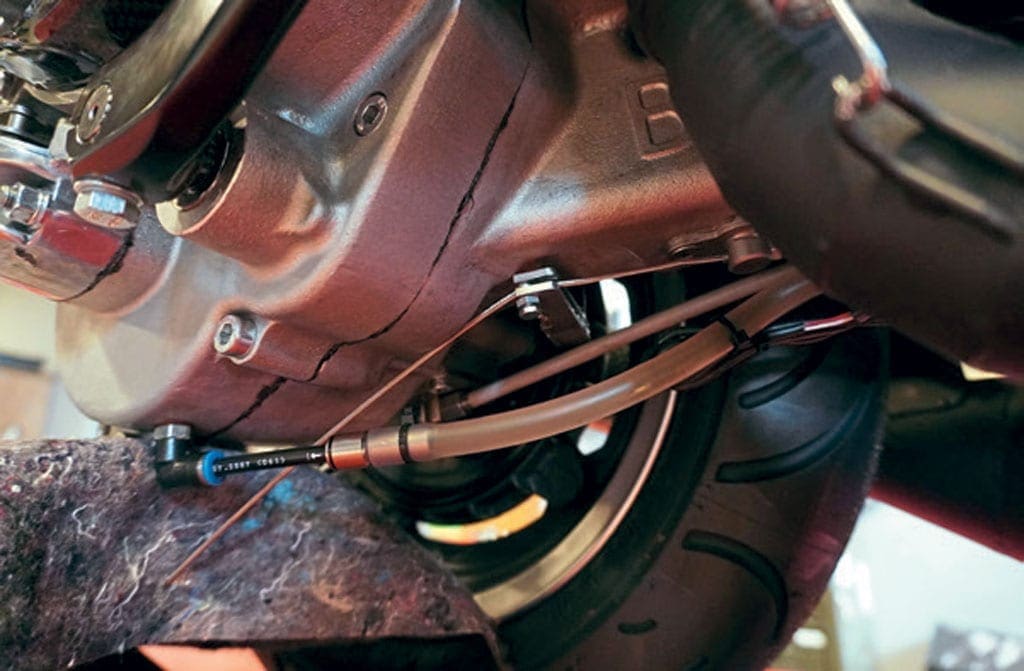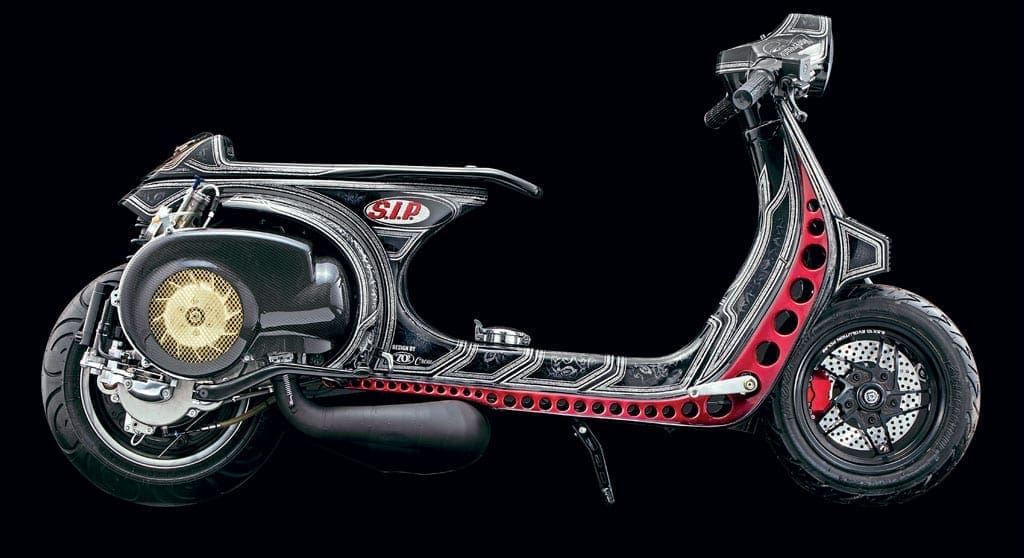
Words: Stan | Photographs: Courtesy of SIP
A 71bhp Vespa engine deserves to be raced and fortunately, that’s exactly what SIP have planned for their 25th-anniversary special.
Looking content, “2019 is a big year for us” began Alex Barth, co founder of SIP. “It’s 25 years since Ralf and I established SIP and we wanted to mark that occasion with something special.
Over the years we’ve produced several customs, but to mark this anniversary we wanted to build something that would encompass our entire history.”
The man charged with bringing the concept to reality was Jesco Schmidt, Product Manager for SIP’s Classic Vespa range.
“We started discussing the project around a year ago,” explained Jesco. “My background is in racing so I was keen to produce something with spectacular performance. As SIP have taken over the 306 engine project from BFA, I thought that showcasing our latest product was an obvious starting point.”
Although Jesco was keen to promote the idea of a racer, Alex had other ideas. “I really dislike scruffy race machines,” he laughed.
“If SIP were to enter a race class, the machine would have to be well finished. As we chatted I realised that there was an opportunity to celebrate our two major markets, Germany and the UK.”
Although there are exceptions to every rule, whilst British custom builders tend to focus on paint and chrome their German counterparts prefer tuning, quite often to extreme levels.
“I thought we could combine both styles and produce a custom-painted racer,” said Alex. “I also made one further stipulation… the finished machine should still look like a Vespa.”

Keeping in shape
That final constraint would prove to be the most demanding of the entire project. “A Vespa frame is designed to carry maybe 12bhp,” said Jesco.
“I hoped to multiply that by six and at that point a standard frame simply twists and distorts. That’s why racers often weld a bracing bar between the headstock and seat mount. The requirement to retain the Vespa’s distinctive silhouette made that unacceptable.”
The man commissioned to solve this problem was Sebastian Attenberger. Well known on the German hot rod scene, Sebastian is an old friend of SIP, being responsible for some of Alex and Ralf’s earlier creations.
As Alex pointed out: “Bringing Sebastian into the project was a great practical decision, but it also followed the theme of involving characters from SIP’s history.”
The result of Sebastian’s hard labour is stunning. Having taken the decision to compete in the sprint class, the first job was to extend the PX’s wheelbase. This enables better weight distribution and gives the rider a fighting chance of keeping the front wheel on the Tarmac.
Although it looks longer, the wheelbase is identical to a Lambretta, the maximum permitted in German scooter sprint regulations. What separates this from other extended frames is the way that Sebastian has fabricated the new sections.
Rather than a simple ‘cut ‘n’ shut’ approach, the extra length has been achieved with a number of progressively smaller sections, creating a telescopic effect.
The frame actually looks as if it could be adjusted in length. Clearly, if a standard frame is subject to twisting under high torque, an extended frame is even more vulnerable and it’s here where Sebastian’s genius has shown itself.
“First the leg shields were removed and the steering head reduced by 10cm,” said Jesco, “then the trimmed leg shields were shifted down by around 50mm. That enabled Sebastian to create what’s effectively a second frame to brace the original. This can now be seen as the red, pierced section.”
Jesco also explained that another benefit of the deeper frame is that it allows internal reinforcement, with no opportunity to add strength or reduce weight being wasted.
“The fuel tank is inside the frame and forms part of the bracing system,” he said. “Cables are also run through conduits that are welded to the frame, adding even more strength.”
A horizontal cut reduces tail height by 8cm and a dropped PK headset completes the aggressive profile. Cut-down Vespa side panels are always difficult to execute well, but Sebastian has sculpted these to perfection. A neatly cut PK horn-cast stands in for the missing mudguard and the only element missing from a production Vespa is the tool box.

Retro flake
With the frame completed, the next stage was to decide the colour scheme and for this another old friend of SIP, Fabrizio Caoduro, was approached.
The founder and owner of Vicenza-based 1970’s Helmets, Fabrizio has an interesting story that we may come back to in a future edition.
For now, it’s sufficient to say he has an unmatched enthusiasm for 1970s style and an unparalleled talent for applying good old-fashioned metal flake. As Alex explained, the inspiration for the scheme came in an unlikely form.
“Moving into our new premises was a major milestone for SIP,” he said. “On our opening day Fabrizio presented us with a longboard skate he’d painted especially for the occasion and it’s been on display in our shop ever since. Taking its scheme linked the project to both a good friend and a vital part of our history.”
The result is simply breathtaking. Every angle produces something new; the depth of lacquer seems infinite, and the red candy adds an industrial look that compliments the 70s inspired graphics to perfection. That anyone would consider launching it down a race track seems crazy, yet that’s this machine’s fate and as any sprinter knows, success is all about power.

Track ready
“Our BFA 306 engine is an incredible unit,” began Jesco. “In standard form it can deliver over 50bhp, but I was convinced we could extract more.”
The BFA’s quality can be measured by the fact that the engine housing, clutch and crankshaft are all from the BFA catalogue. The magic is in Jesco’s porting and adjustment of the transfer timing.
Jesco also paid tribute to Mathias Scherer, who produced a one-off exhaust for the project. For the carburettor Jesco chose a 42mmm DEA, revising the intake manifold to accommodate an Italkit membrane.
The result of all this work is an amazing 71.4hp at the crankshaft and 75hp at the clutch.Although power is critical, sprinting success depends on how efficiently gears can be selected, and it’s here that some really clever engineering comes into play.
“The gear shift is a Motorino Diavolo sequential system connected to an electric servomotor, and operated by two buttons on the handlebars,” said Jesco.
“The servomotor is connected via a linkage to the selector box, and our biggest problem was adjusting its ratio to the Motorino Diavolo’s settings. Another discovery was that the forces on the mechanical parts were so large that we had to incorporate a small damper into the shift rod. We also paid attention to the clutch, which is pump injected with gear oil sucked from the bottom of the motor housing. This cools the clutch during launch and is switched on automatically when a gear is engaged.”
Serious consideration was given to engraving or chroming the cases, but this machine is to be raced. Practicality dictated that aesthetic improvements would be confined to a one-off, one-piece carbon fibre cowl set.
It’s not unreasonable to say that SIP’s sprinter sets a new bar in the world of custom racers. It’s not just technically accomplished; in combining so many elements of their 25-year history it’s a work of genius. If this is SIP’s silver special, roll on gold.



